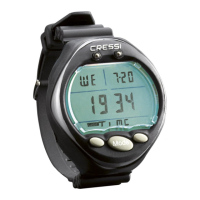
Do you have a question about the Cressi Archimede II and is the answer not in the manual?
| Type | Dive Computer |
|---|---|
| Display | LCD |
| Battery Type | CR2450 |
| User Replaceable Battery | Yes |
| Ascent Rate Indicator | Yes |
| Altitude Adjustment | Yes |
| Audible Alarms | Yes |
| Algorithm | Cressi RGBM |
| Modes | Air, Nitrox |
| Nitrox | Yes |
| Battery Life | Approximately 300 dives |
| Logbook | Yes |
| Water Resistance | 100 meters / 330 feet |
| Max Depth | 100 m / 330 ft |
Covers algorithm, tissues, and key features like Program Dive, Nitrox, Gage, UFDS display.
Essential safety information including definitions and general recommendations.
Explains the meaning of DANGER, WARNING, and NOTE symbols used throughout the manual.
Provides warnings on reading the guide, DCS risks, proper usage, altitude, flying, Nitrox, and sport diving limits.
Introduces the Archimedes II as a multifunctional sport diving computer and its features.
Explains the User Friendly Display System (UFDS), icons, and button functions for navigation.
Details altitude adjustments, checking battery/display, and pre-dive considerations.
Explains how to set dive parameters by selecting programs (DIVE, GAGE).
Covers setting PO2, FO2, Safety Factor, Max Depth, and ON/OFF for the DIVE program.
Explains using the PLAN function to visualize remaining time at different depths before a dive.
Describes how to quickly view set parameters for a dive, like PO2, max depth, safety factor.
Introduces the GAGE program for depth/time tracking without saturation computations.
Covers general device settings like alarms, date/time, and units.
Explains how to set the maximum depth alarm and its parameters for safety.
Details how to adjust the date and time settings on the dive computer.
Describes changing between metric and imperial units for depth and temperature.
Details information displayed during an air dive, including depth, NDL, and dive time.
Introduces Nitrox diving and its specific settings and considerations.
Emphasizes training and setting the computer with correct O2 percentage for Nitrox dives.
Covers setting crucial Nitrox parameters like PO2 and FO2.
Explains how to set the PO2 value for Nitrox mixtures, crucial for safety.
Details setting the FO2 percentage for Nitrox mixtures, affecting decompression calculations.
Explains the CNS toxicity graph and its alarms, indicating oxygen intoxication risk.
Describes the PO2 alarms that signal exceeding depth limits related to set PO2 values.
Explains analysis of dive profiles and ascent rates.
Explains how the computer indicates ascent rates and alerts for exceeding them.
Details the automatic safety stop feature for dives deeper than 32 ft. to enhance safety.
Alerts the diver when approaching no-decompression limits, allowing for adjustments.
Explains information provided if no-decompression limits are exceeded.
Describes the alarm and consequences if a decompression stage is missed.
Introduces the GAGE program for depth/time tracking, useful for apnea/technical divers.
Covers on-surface functions including logbook, dive history, dive profile, and PC transfer.
Explains de-saturation time, the "Don't Fly" icon, surface time, and residual nitrogen graph.
Describes how the computer memorizes dives, LOG function activation, and the detailed information recorded.
Explains the dive history memory function and the aggregated information it stores.
Details how to view dive profiles stored in the logbook, including depth, time, and decompression.
Outlines PC specs and software for transferring and analyzing dive data.
Explains how to reset the instrument, its effects on computations, and retained data.
Introduces simulation features for practice and planning.
Describes the simulator program for familiarizing with functions and planning dives.
Explains simulating subsequent dives with residual nitrogen and modifying surface interval.
Explains how to replace the battery, warnings about data loss, and resetting settings.
Provides reference tables for no-decompression limits.
Presents tables for no-decompression limits for air and Nitrox mixtures at various depths.
Outlines the warranty terms, coverage, exclusions, and requirements for service.
